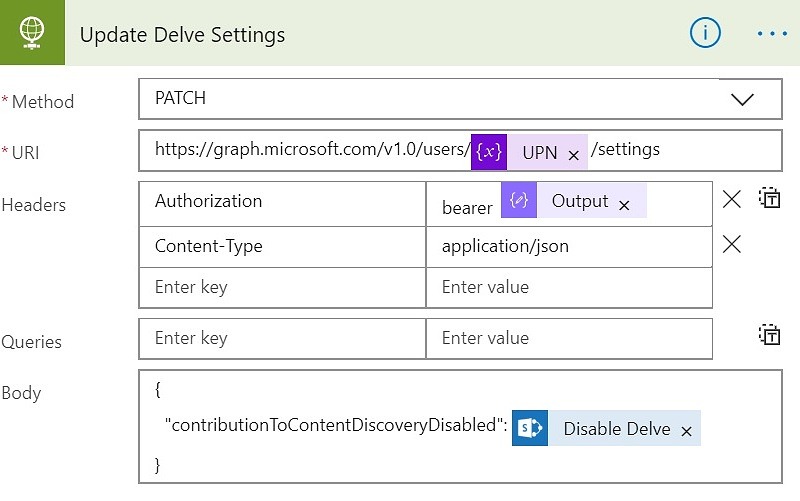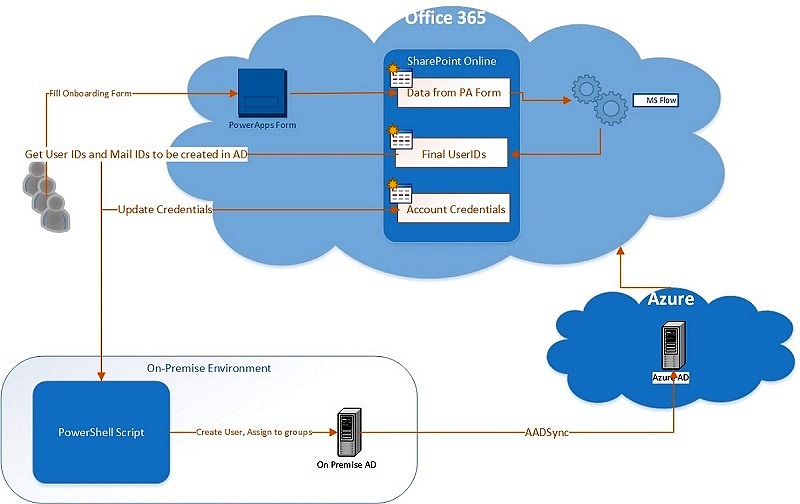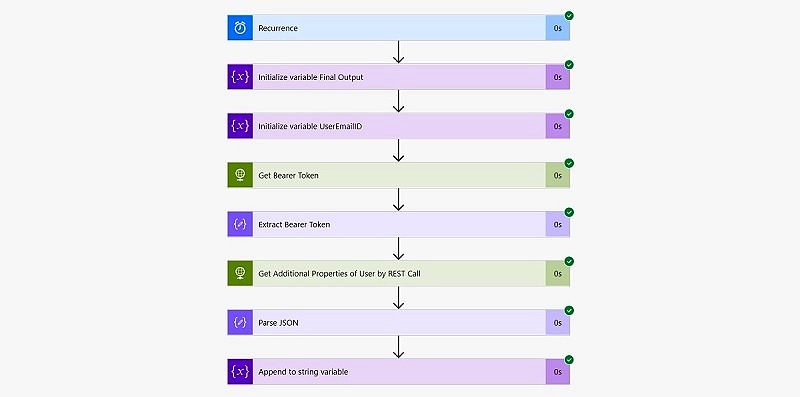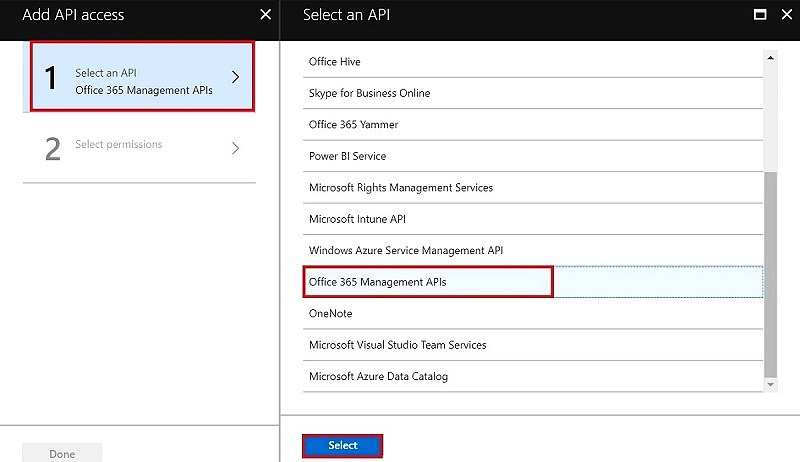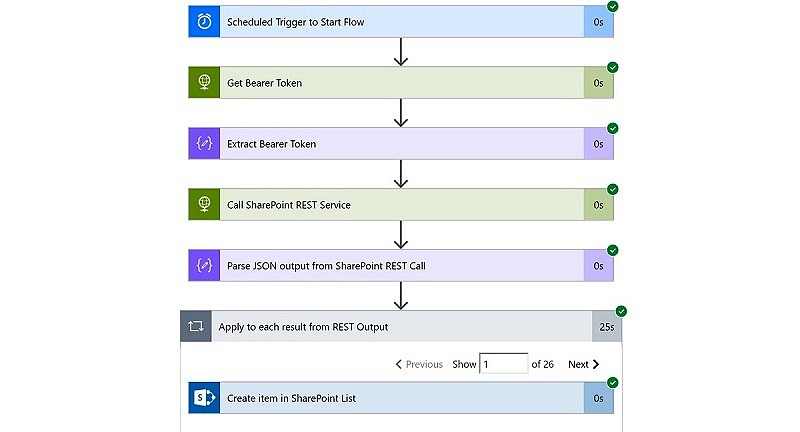Office 365 users seem to have love and hate relationship with Delve. Some love it for ease of access to content which would otherwise be difficult to find and others hate it for the very same reason, that it opens up the fault lines in their SharePoint setup where sites permissions are not kept updates when users move around various teams. Problem Statement The best way to define it would be – The “fear of unknown”, like “I don’t know which of my files will start appearing to everyone else”, is common among senior management and some users working in […]
Automate On-Premise AD Account Creation with MS Flow
I was recently asked to work on Automating the on-premise Active Directory Account creation. The idea was simple – Hiring manager fills up a form with the required details about the new joinee and submits and then the account should get created in On-premise AD and eventually be synced with Azure AD with required licenses assigned. The obvious expectation was to use available tools only which come as part of Office 365 E3 license suite. Unfortunately Custom HTTP calls to Microsoft Graph became a Premium Connector in February 1, 2019 and now requires a P1 or P2 license. Implicit Requirements […]
Access On-Premise Extension Attributes from Azure AD in MS Flow
I recently came across a requirement where I needed to read SamAccountName and some ExtensionAttributes from Azure AD which are synced with On-Premise AD. I thought since all the On-premise attributes are being synced using Azure AD Connect, it should be easy enough to read those values from Azure AD using PowerShell or Microsoft Graph APIs. Unfortunately Custom HTTP calls to Microsoft Graph became a Premium Connector in February 1, 2019 and now requires a P1 or P2 license of MS Flow. Getting Started Before I jumped into the solution, I wanted to be sure that Extension Attributes are indeed […]
Easily Switch Between Multiple Accounts in Office 365
More often than not, in Office 365, IT workers find themselves using multiple accounts. Like one account for normal user access, another with Tenant Admin permissions and so on. Even though, the interface for switching logged in accounts in office 365 has become better now, than it used to be few months ago, it still leaves a lot to be desired. If you use Microsoft Edge Browser, look at this article instead, which explains how to achieve the same with Egde. What’s the Problem Let’s take a look at what we are talking about. Suppose you have 2 different accounts, […]
Automate License Assignments in Office 365
License assignments has been one of the core governance concerns in Office 365 . With ever growing list of Office 365 Services and mix of license types (like E1, E3, E5 and a combination of those), this has created another world of processes (and PowerShell scripts) to keep up. So, what can we do to help reduce the amount of efforts spent on this? Yes, you got it right, Automate! Why bother about it? Before we jump into the solution, let’s spend some time on understanding “why” it is required in the first place. In most medium to large size organizations, […]
Implement Custom Alert Policies in Office 365
Alert Policies are a bit of hidden gems in Office 365. There are a wide list of activities which can be tracked using these alert policies and a notification can be received when such activities/events occur. As per the official definition, we can use alert policies to track user and admin activities, malware threats, or data loss incidents in Office 365. After choosing the activity you want to be alerted on, refine the policy by adding conditions, deciding when to trigger the alert, and who should receive notifications. Alert Policies Alert Policies are part of Office 365 Security & Compliance […]
Office 365 Management Activity API to Automate SharePoint Governance
In one of my previous articles, I talked about How to use Azure Text Analytics Service to Automatically Tag SharePoint Documents. One of the alternatives for implementation I pointed out was using Office 365 Management Activity API to identify when a document gets uploaded and trigger the metadata tagging. In this article, I am going to go in a bit more detail about how that can be achieved. However, by the end of this article, it should be fairly clear to you that similar solution can also implement various different scenarios to automate SharePoint governance. Introduction Summarizing the introduction from […]
Sync Files on Demand with OneDrive Client
In a complete Office 365 implementation, every user gets a personal web space called OneDrive Site. This is a place where they are supposed to store files which are not supposed to be shared or ready to be shared with larger audience. OneDrive for Business sites combined with OneDrive client provides great way to ensure users are truly mobile. It allows them to access their files anywhere from any device, of course, depending on organizational policies. Organizations have love-hate relationship with OneDrive – Some have accepted it to the core whereas others see it as a potential security hazard, which […]
How to Call SharePoint REST WebService from Microsoft Flow
Microsoft Flow is getting better and better with each passing day. It now has thousands of templates to get you started quickly and provides connectors for hundreds of other services. Flow can be invoked from across various external applications as well, but I guess, the most immediate users would come from SharePoint world 🙂 I wrote an article earlier about how Microsoft Flow can be used to Enable Incoming Mails in SharePoint Online. In this article, I am going to explain how to connect with SharePoint Online, extract some data using REST Services and send it for further processing. Getting […]
Migrate Files Shares to Microsoft Cloud
File shares have been a beloved way to store and share documents around various groups for years. Even though, many organizations moved to collaborative solutions like SharePoint years ago, File Shares didn’t lose their charm. Because of the ease of usage and historical knowhow, it continued to grow both in size and usage over years. I know many organizations who store say 5 terabytes of data in SharePoint, still have four times more data in File Shares. But things are not all rosy with File Shares. Why Move out of File Shares Let’s a take quick look at why we […]
